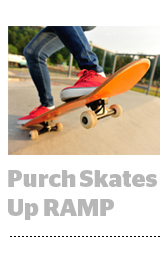 Some publishers believe programmatic creates a “race to the bottom” for its inventory. Purch, whose portfolio includes TopTenReviews and Tom’s Guide, is taking the opposite approach by using programmatic to establish the baseline value of its media.
Some publishers believe programmatic creates a “race to the bottom” for its inventory. Purch, whose portfolio includes TopTenReviews and Tom’s Guide, is taking the opposite approach by using programmatic to establish the baseline value of its media.
This effort, called Purch RAMP (revenue and advertising management platform), will help it create premium, custom advertising opportunities. Call it the race from the bottom.
RAMP starts out solving a familiar problem for publishers: managing header bidding partners. It then saves and stores that bidding information, and applies analytics to understand “the true market value of all our promotional inventory,” said CRO Mike Kisseberth.
“Programmatic is the base,” CTO John Potter said of its bottom-up approach. RAMP :”allows the direct guys to know if their deals are wasting their time or not.”
Since Purch started using RAMP in October, it’s grown header bidding partners to more than a dozen and has increased average CPMs on the open marketplace by 30% from this time last year, thanks to better competition between programmatic partners. Consequently, Purch has stopped working with ad networks, who couldn’t compete with these higher CPMs.
Additionally, RAMP’s tag management functions keep header bidding code from dragging down Purch’s sites with latency and technical issues.
RAMP also does server-side integrations with most of its header bidding partners, which allows buyers to identify the users they want to reach beforehand. That makes for more complete, efficient decisioning and fast load times.
Purch tracks activity from its dozen header bidding partners, analyzing it to learn what content and audience drives the highest value. This insight lets Purch adjust floor prices based on audience characteristics or page context.
Purch claims not to partake in the controversial practice of raising floor prices when bids are high, which Kisseberth said is unsustainable.
“If someone bids at an $80 CPM, we could set [the floor price] to $80, but the goal is to get to true market value for both sides,” Kisseberth said.
Programmatic only accounts for a quarter of Purch’s revenue. The publisher applies RAMP’s yield management capabilities to direct buyers as well.
For instance, after using RAMP to determine the value of inventory on a laptop review page, Purch did a test, measuring the performance of a native buy button unit for the product both with and without other ads on the page.
Usually, performance increases without extra ads cluttering the page – moving conversions from .5% to 11%, according to Kisseberth. How much should Purch charge a direct buyer to remove all extraneous ad units from the page in favor of a native ad placement with a buy button? With RAMP, Purch can figure it out.
Since buy buttons on review pages have finite scale, Purch complements those native placements with standard IAB units to scale up performance. For example, Purch can create a private marketplace targeted to areas RAMP determines are high value.
This data-driven selling approach helped Purch increase direct sponsorships 76% YoY, and private marketplace revenue increased 420% YoY.
“We want to strike that deal with the marketer where we can meet or beat the performance they get anywhere else,” Kisseberth said. “That builds sponsorship relationships that renew and scale. It’s not just a one time thing that goes away because you didn’t hit the metric.”
The next phase of RAMP will integrate with Purch’s content management system, allowing Purch to measure the value of native ads and banner ads on the same page. Based on that information, Purch could show whatever ad unit will bring in the most value. Now, many native ad units are hard coded, making quick adjustments or audience-specific decisioning impossible.
Bringing native into RAMP will help insulate it from declines in display advertising. “As ad blocking spreads, it’s important for native to actually be native,” Potter said. “We can serve native advertising the way we serve content.”
The first phase of RAMP has shown Kisseberth firsthand the limitations of standard display ads, reinforcing Purch’s focus in native formats. While RAMP helps Purch increase yield with standard IAB units, there’s a cap to the value one can extract from the format, Potter said.
“By being more customized in the way you promote that offering,” he said, “you can get much higher performance levels.”













